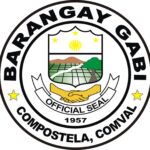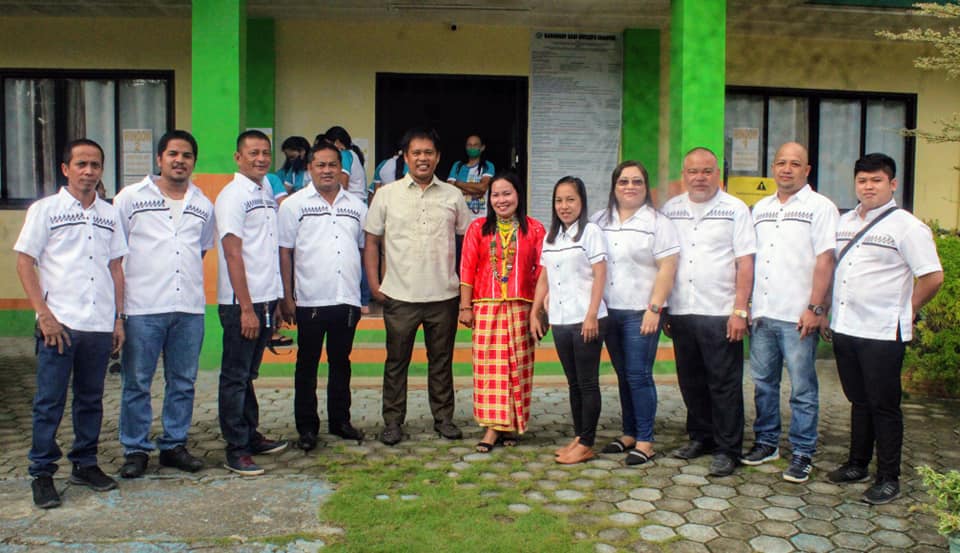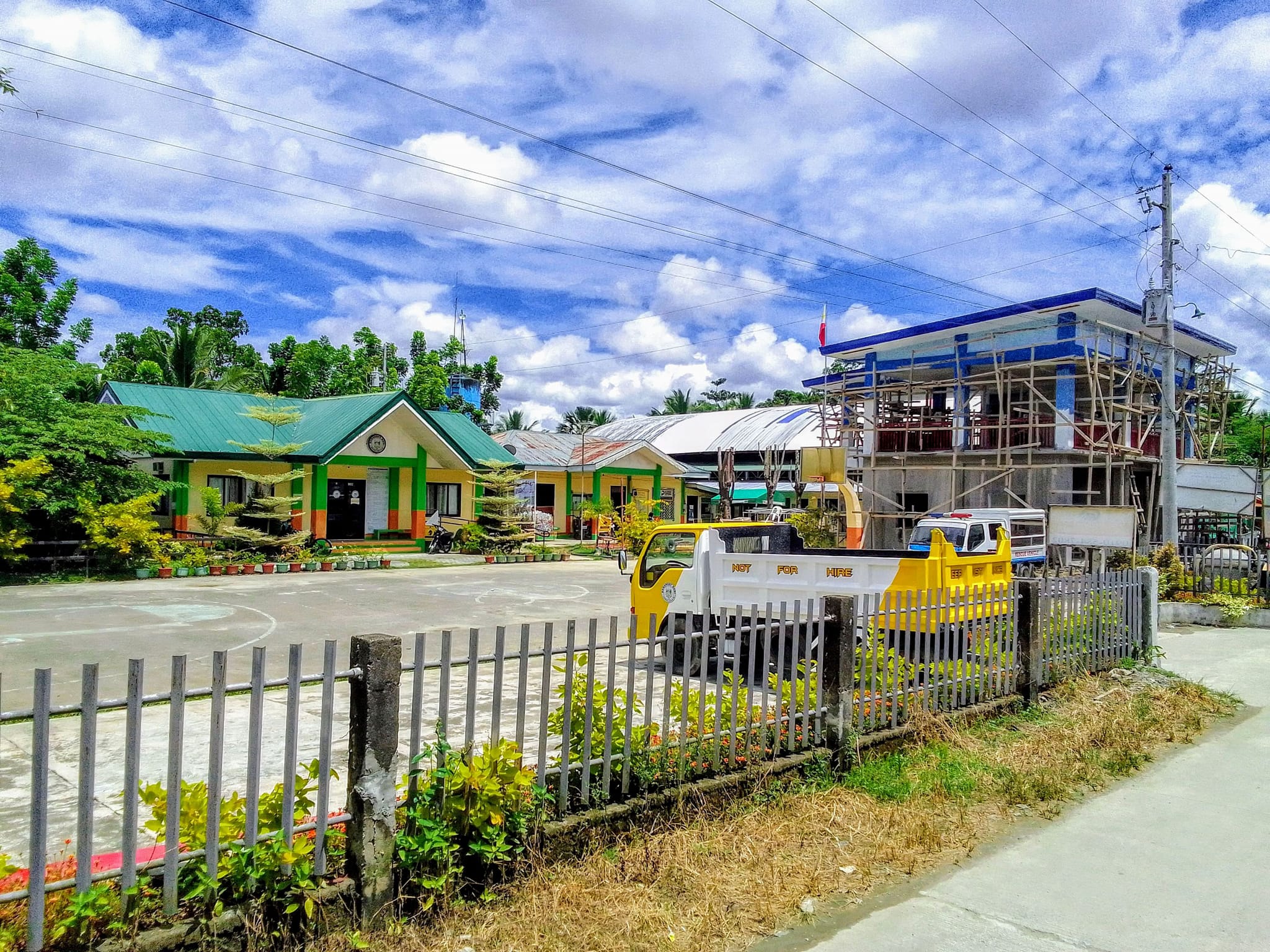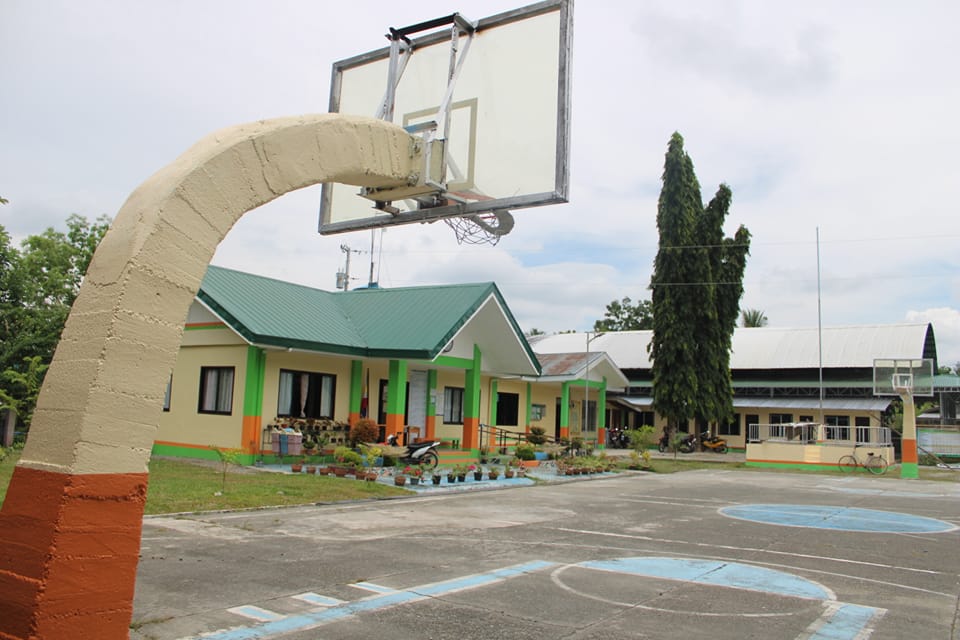GABI
Barangay Gabi Is One Of The 16 Barangays Of The Municipality Of Compostela, Compostela Valley Now Davao De Oro, Created On June 23, 1957 Under Republic Act No. 2039 Signed By The Late President Carlos P. Garcia.

According To The Early Settlers, The Barangay Got Its Name From The Native Word Gabi Which Means “Night”, But Some Said That It Came From A Name Of Plant “Gabi” Which Was Grown At The Middle Of The Lake And Other Said That It Was Also Came From The Name Of The Said Plants Grown Around The Lake. Barangay Gabi Has Its First Sitios And These Were Inopawan (Which Is Now Under The Jurisdiction Of Barangay Panag In The Year 1973), New Alegria (Now One Of The Barangays In Compostela Declared In The Year 1969), Alda (Now Barangay New Dauis And Barangay Magading Which Are Now Under The Jurisdiction Of The Municipality Of Nabunturan In The Year 1972 And 1964 Respectively) And Valencia (Now One Of The Puroks In Barangay New Alegria).

The First Family Residing In The Barangay Were Mr. & Mrs. Luis Sampangan Who Were Native In The Land Followed By Mr. & Mrs. Fausto Quiño Who Migrated From Alegria, Cebu In The Year 1930s. The Latter Constructed His House At The Top Of Cut-Stalk Of Big Tree, Visayan Term “Tuod” Which Was Very Prevalent Tree At Their Time.
The People Of Barangay Gabi Were Mixture Of Different Tribes Such As Cebuano, Boholano, Mandaya And Some Ilonggos And Ilocano. At The Very First Year Of Its Civilization, There Were Only Six (6) Tribes Who Came In And These Were Cebuano, Boholano, Mandaya, Ilocano, Leytenyo And Chinese. The First Cebuano Family Who Settled In The Barangay Were The Family Of Francisco “Paran” Jamero In The Year 1937 While Pablo Pesquera Was The First Boholano. In The Year 1942,
There Were Several Native Mandaya Tribe Arrived In The Barangay. These Were Luis Sampangan Together With His Children Sumagling, Bangkong And Sinudlay. However, The Last Three Names Were Then Go Back To Their Place Of Origin And Only Luis Sampangan Stayed And Was Considered As The First Person Who Settled In The Barangay. Ilocanos Were Also Able To Migrate In The First Years Of Barangay Gabi’s Civilization, They Were Pedro Gines And Rosal Cabasan. Lastly, The First Chinese Migrated Was Ignacio Ganto In The Year 1961. All Of Them Came In The Barangay And Found Their Living By Cultivating Its Land To Produce Products.
Churches Were The Centers Of Faith And Devotion Of The Community. It Was The Place Of Sourcing Out Guidance From A Heavenly Being. In The Year 1949, The Family Of Mr. Teotimo Jamero And Mrs. Cerila Jamero Initiated The Establishment Of The First Church In The Barangay. They Brought Their Religion From Alegria, Cebu Which Was Romano Katoliko And Named Its First Patron Chapel “San Francisco Javier”. Its First Chapel Was Constructed On The Residence Of Quintin Lendio In New Alegria Who Was Also The First Chapel President. The Church Has Its Very First Members Consisting Only 14 Persons, Namely; Teotimo Jamero, Francisco Jamero, Pastor Barrientos, Agaton Lendio, Alberto Alcala, Silvestre Jamero, Generoso Delostrico, Domingo Lagawan, Pablo Pesquera, Quintin Lendio, Catalino Lejaño, Pablo Carreon, Fausto Quiño And Martin Carreon. In 1951, The Chapel Was Transferred To The Residence Of Generoso Delostrico In New Alegria, Who Was The Second Chapel President. On The Same Year, The Very First Mass Was Held And Was Officiated By A Canadian Priest Fr. Lavel. Five Years Later, In 1956, The Church Was Again Transferred In The Barangay Site With Its Another Chapel President Martin Carreon And Its First Three (3) Kaabag Artemio L. Lerio, Iñigo Mantua, And Brigido Lorono. As Years Gone By, The Church Have Developed And In The Year 2007, It Became A Quasi-Parish With Its First Parish Priest Fr. Jose A. David. On September 26, 1956, Another Religious Sector “Iglesia Ni Cristo” Was Established Which Was Initiated By A Romano Katoliko Member Mr. Domingo Lagawan. Its First Missionary Activity Was In Valencia, A Former Sitio Of Barangay Gabi, And Its First Head Deacon Was Zoilo Lagrosas. The Iglesia Ni Cristo Local Chapel Was Then Transferred To Barangay Site (Now Purok 7) On January 1957 And Named As Gabi Local Chapel. In Its New Local Chapel, Jimmy Aguilar Was The First “Ministro” With 22 Members. On December 1998, INC Local Chapel Was Transferred Again To Purok 10, Gabi With Its New Head Deacon Ruben I. Haspe And “Ministro” Dominador Blancada. While In The Year 1956, A Person Named Eulogio Gador Established “United Church Of Chirst In The Philippines” In Inopawan, Also One Of The Former Sitios Of The Barangay. At Present, Several Religious Sectors Have Risen Due To Rapid Migration And Civilization Of The Barangay.

School Was The Center Of Molding The Citizens Into Responsive And Innovative Constituents For A Progressive Development Of The Barangay. The First Elementary School Was Established In 1955. Its First Known Teachers Were Saturnina Arocha, Magna Arangcon, Felomina Lendio, Marciana Aglibot, Didia Acedilla, And Sofia Opay. Due To Rapid Development Of Its Youth, A Higher Learning Was Needed To Further Their Learnings. With That, On September 25, 1966, Gabi Community High School Has Risen. The First Classroom Was The Storage House Of The Late Mr. Isaac Lendio Who Voluntarily Offered The Space For The School’s Very First Students. Mr. Gervacio Miasco And Mr. Josue Rico Were The First Teachers Of The School And Was Spearheaded By Mr. Luis Parungao. Eight (8) Pesos Was Given To The Aforementioned Teachers By The Barangay Officials Every Month As Honorarium. Throughout The Years, Gabi Community High School Developed And Now Known As Gabi National High School Which Became The Center School Of Its Neighboring Barangays.
At Its Very First Year Of Declaration As One Of The Barangays In The Municipality Of Compostela. The Tenyente Del Barrio (Now Punong Barangay) Has Its Office Inside His Residence. However, In 1980s, The First Barangay Hall Was Constructed Together With Its First Barangay Health Center. The First Barangay Hall Was Situated Beside The Current Basketball Court Of The Barangay Where The Governing Officials Held And Provide Their Public Services. In 1990, The Barangay Hall Was Transferred To Another Site Near To Its Former Barangay Hall And Was Rehabilitated In 1996. As The Barangay Developed, Gabi Gymnasium Was Constructed In 2005, But A Storm Named Pablo On December 4, 2012 Devastated The Facility And Was Then Rehabilitated Through The Help Of Former Congresswoman Maria Carmen Zamora. Barangay Gabi Day Care Centers Were Also Created In The Year 1991 And In 2015, Respectively. Creation Of Its Annex Was Due To The Rapid Number Of Pupils. At Present, The Newly Constructed Barangay Hall Was Located Beside Its Former Barangay Hall. It Was Constructed In The Year 2019 Funded By Former Congresswoman Maria Carmen Zamora And During The Making Of The Barangay Development Plan (BDP).

At Present, Barangay Gabi Has Over 5, 000 Population Comprising Diverse Cultures, Religions And Livelihoods. In General, The People Of Barangay Gabi Are Industrious, Peace Loving, Enterprising,
God-Fearing And Self-Reliant For The Barangay To Move Forward And Create Opportunities For Its
Constituents And Are Keeping On Making Good History And Innovations For The Coming Years Of
Development.
Major Events In The History Of The Barangay:
In 1955, A Mountain In Camiguin Named Mt. Hibok-Hibok Erupted Which Resulted To An 8-Month Drought Which Affected This Barangay’s Agricultural Activities. Several Crops Were Damaged Specifically Rice Farm Because Of Water Insufficiency. Seven Years Later, Another Drought Was Felt By The Constituents Which Damaged Their Major Crop Productions. This Calamity Lasted For 11 Months Which Made The Residents Of Miral, Magsaysay, Davao Del Sur Migrated To Agusan Del Sur.
In 1961, A Heavy Rain Caused The Batutu River To Overflow Which Resulted To A Huge Flood And
Damaged Several Crops In The Barangay Including Its Neighboring Barangays. Another Flood Was
Recorded In The Year 1964 Which Damaged The Materials For The Proposed Tennis Court Project Of
Barangay Gabi Funded By Presidential Assistance For Community Development (PACD). In The Year
1971, Months Of September And October, Pests Like Rats Attacked The Rice Fields Of The Barangay.
Due To The Long-Term Attacked Of These Pests, Most Of The Constituents Harvested Only 11 Sacks Of
Rice Per Hectare. After All Of Those Floods And Pests Attacked, A Drought Attacked Again In The
Year 1982-1983. This Drought Lasted For 9 Months Starting July 1982 To March 1983. On December
Sixteenth, Year 1991 At Exactly 2:45 AM Before The Misa De Gallo Started, A Huge Earthquake Hit
With A Magnitude Of 6.5. Most Of The Road Facilities And Residential Buildings Were Damaged.
Another Earthquake Recorded And It Was On May 16, 2004 At 6:00 In The Evening With 6.9
Magnitude. This Earthquake Cracked The Batinao Road With Almost 1-Meter Crack. It Was The
Reason Of The Uneven Land In Purok 1, 9 And 11. In The Year 2012, Fourth Day Of December At 4:00
Am, Super Typhoon Pablo Hit The Provinces Of Davao Oriental, Compostela Valley (Now Davao De
Oro) And Portion Of Agusan Del Sur. In Barangay Gabi, Most Of The Facilities, Residential Buildings
And Crops Were Damaged Which Made Big Changes On The Perpendicular Life Status Of Every
Constituent In The Locality. Lastly, The Latest Calamity That Hit The Barangay Was The Tropical
Depression Agaton In The First Quarter Of 2013, It Brought The Hugest Flood Ever Recorded. This Was
Happened Particularly On The Eight Day Of January, 2013. Despite All Those Calamities, People Of
The Locality Were Strong Enough To Face Their Tomorrows And Continue To Look Forward For The
Development Of The Barangay Together With The Local And National Governments Who Keep On
Educating People To Be A Disaster Resilient Community.
Its population as determined by the 2020 Census was 4,968. This represented 5.53% of the total population of Compostela.
Demographics
Households
The household population of Gabi in the 2015 Census was 4,725 broken down into 1,160 households or an average of 4.07 members per household.
details
| Census date | Household population | Number of households | Average household size |
|---|---|---|---|
| 2,547 | 462 | 5.51 | |
| 3,059 | 585 | 5.23 | |
| 3,533 | 713 | 4.96 | |
| 3,879 | 847 | 4.58 | |
| 3,891 | 901 | 4.32 | |
| 4,725 | 1,160 | 4.07 |
Population by age group
According to the 2015 Census, the age group with the highest population in Gabi is 10 to 14, with 515 individuals. Conversely, the age groups with the lowest population are in the ranges 75 to 79, and 80 and over, with 40 individuals.
details
Combining age groups together, those aged 14 and below, consisting of the young dependent population which include infants/babies, children and young adolescents/teenagers, make up an aggregate of 30.84% (1,457). Those aged 15 up to 64, roughly, the economically active population and actual or potential members of the work force, constitute a total of 64.06% (3,027). Finally, old dependent population consisting of the senior citizens, those aged 65 and over, total 5.10% (241) in all.
The computed Age Dependency Ratios mean that among the population of Gabi, there are 48 youth dependents to every 100 of the working age population; there are 8 aged/senior citizens to every 100 of the working population; and overall, there are 56 dependents (young and old-age) to every 100 of the working population.
The median age of 25 indicates that half of the entire population of Gabi are aged less than 25 and the other half are over the age of 25.
| Age group | Population (2015) | Age group percentage |
|---|---|---|
| Under 1 | 89 | 1.88% |
| 1 to 4 | 362 | 7.66% |
| 5 to 9 | 491 | 10.39% |
| 10 to 14 | 515 | 10.90% |
| 15 to 19 | 449 | 9.50% |
| 20 to 24 | 437 | 9.25% |
| 25 to 29 | 417 | 8.83% |
| 30 to 34 | 321 | 6.79% |
| 35 to 39 | 268 | 5.67% |
| 40 to 44 | 280 | 5.93% |
| 45 to 49 | 302 | 6.39% |
| 50 to 54 | 241 | 5.10% |
| 55 to 59 | 183 | 3.87% |
| 60 to 64 | 129 | 2.73% |
| 65 to 69 | 98 | 2.07% |
| 70 to 74 | 63 | 1.33% |
| 75 to 79 | 40 | 0.85% |
| 80 and over | 40 | 0.85% |
| Total | 4,725 | 100.00% |
|
||
Click on or hover over the bars to see the population of each age group.
The population of Gabi grew from 2,547 in 1990 to 4,968 in 2020, an increase of 2,421 people over the course of 30 years. The latest census figures in 2020 denote a positive growth rate of 1.06%, or an increase of 243 people, from the previous population of 4,725 in 2015.
| Census date | Population | Growth rate |
|---|---|---|
| 2,547 | – | |
| 3,059 | 3.49% | |
| 3,533 | 3.14% | |
| 3,879 | 1.30% | |
| 3,891 | 0.11% | |
| 4,725 | 3.77% | |
| 4,968 | 1.06% |
Location
Gabi is situated at approximately 7.6076, 126.0562, in the island of Mindanao. Elevation at these coordinates is estimated at 83.3 meters or 273.3 feet above mean sea level.






Adjacent barangays
Gabi shares a common border with the following barangay(s):
- San Miguel, Compostela, Davao de Oro
- San Jose, Compostela, Davao de Oro
- New Alegria, Compostela, Davao de Oro
- Katipunan, New Bataan, Davao de Oro
- Siocon, Compostela, Davao de Oro
- Magangit, New Bataan, Davao de Oro
